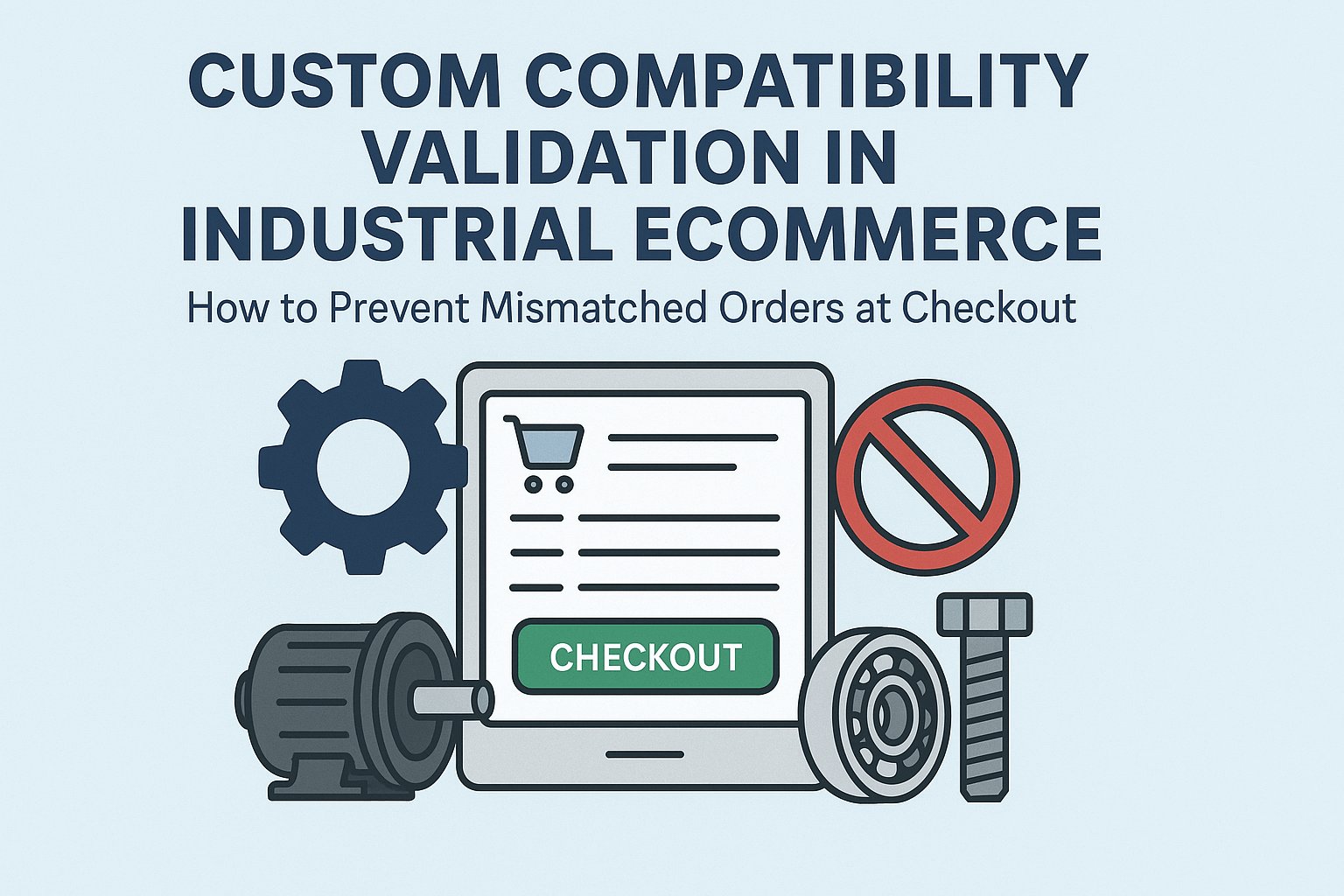When the Wrong Bolt Ships, the Whole Relationship Breaks
In industrial ecommerce, a return isn’t just a transaction reversal; it’s a breach of trust. When a customer orders a hydraulic fitting that doesn’t match their thread type, or a control panel that doesn’t integrate with their voltage spec, the consequences cascade. Delays compound. project stalls. Phone lines light up. Your support team scrambles for answers, while your customer quietly begins researching your competitor.
And most of the time, this error is caused by the system. The platform lets them add an incompatible item to the cart. No warnings. No checks. No guidance. You made it easy for them to fail.
That’s the problem we’re fixing today.
This article is for industrial brands with complex, technical product catalogs, where the right product depends not just on category, but on context. Voltage. Thread size. Material compatibility. Bore diameter. Regulatory region. It’s engineering-grade commerce. And when one part doesn’t fit, your customer doesn’t just return it; they question everything about your brand.
But it doesn’t have to be this way.
With custom compatibility validation logic at checkout, or even better, pre-checkout, you can intercept these problems before they become pain points. You can prevent incorrect orders, reduce returns, and most importantly, show your customers that you understand what they’re trying to do and you’re going to help them do it right.
Let’s walk through exactly how.
Why Compatibility Issues Are So Common in Industrial Ecommerce
Let’s start with a truth: your buyers are smart, but they’re also rushed. They’re sourcing under pressure, juggling specs across systems, and often ordering on behalf of someone else. That’s how a procurement manager ends up ordering a 24V relay for a 12V system, or a left-hand thread fastener for a right-hand application. One wrong click, and the chain reaction begins.
Now layer on the complexity of your own catalog. If you’re an industrial supplier with 10,000 SKUs, half of them look nearly identical unless you’ve trained an eye. Product names are cryptic. Specs are buried in PDFs. Some parts require a specific flange size or housing diameter, but your platform doesn’t enforce that logic. So it lets anyone add anything to the cart.
It’s not that your customers don’t care about precision. It’s that your system doesn’t protect them from a wrong move.
Here’s what makes this worse:
- Lack of guided selling tools. Most industrial sites don’t offer true configurators or selectors. The buyer is left to guess.
- Missing compatibility logic. Shopify and BigCommerce weren’t built with engineering logic in mind. They let people add whatever they want.
- No visibility into downstream dependencies. The system doesn’t know that a valve won’t work unless the upstream connector is rated to a specific pressure tolerance.
And this disconnect hurts everyone:
- Customers lose time.
- Sales reps field unnecessary calls.
- Ops and fulfillment teams absorb avoidable returns.
- Your brand takes the hit for a mistake the system should’ve caught.
It’s not just a UX problem, it’s a credibility problem. And it’s one of the fastest ways to create friction in accounts that would’ve otherwise become loyal repeat buyers.
That’s why we don’t just need “better product pages.” We need systems that understand and enforce technical truth.
And that’s where custom compatibility validation comes in.
What “Custom Validation” Really Means (and Why Object Value Matters)
Let’s strip away the buzzwords.
“Validation” isn’t about dropdown warnings or generic out-of-stock notices. We’re talking about logic enforcement, a system that understands the relationship between your products and blocks bad combinations before they ever hit your warehouse.
Think of it like this: if your customer is buying a motor, the system should already know whether their selected drive, housing, or voltage regulator is compatible. If it’s not, the system shouldn’t just warn them. It should intervene.
At its core, we can say custom validation is a three-part framework:
- Definition of compatibility rules.
Someone, usually your product engineers or technical sales team, needs to outline what does and does not go together.
- Example: SKU A (a flange) is only compatible with SKUs B, C, and E.
- SKU D (a sensor) must not be paired with SKU F unless a converter is also in the cart.
- Integration of those rules into your ecommerce platform.
This is where development matters.
- In Shopify Plus, we can use Shopify Functions, Liquid logic, or metafield checks during cart and checkout.
- In BigCommerce, we use custom scripts, Cart Hooks, or the Checkout SDK to evaluate product relationships in real time.
- Buyer-facing interactions.
This is the piece most brands get wrong.
- It’s not enough to just block the order.
- You need to explain why, show alternatives, and keep the buyer moving forward, not bouncing in frustration.
Here’s how it works in practice:
A buyer adds an industrial fan to their cart, but it requires a 3-phase power supply. The system detects that the current configuration is for single-phase, flags the mismatch, and offers two options:
- Swap to a compatible fan.
- Add the correct transformer to the cart.
That’s guided protection, a system that understands both the physics and the purchase logic.
And that experience tells your customer:
“We’re not just here to sell, we’re also here to make sure what you’re buying works.”
That kind of trust? It’s not just a UX win. It’s a retention strategy.
Engineering Compatibility Logic in Shopify Plus and BigCommerce
Most ecommerce platforms weren’t built for complex product relationships. They were built to sell shoes, t-shirts, and coffee mugs. So when you’re selling circuit breakers, pipe couplings, or gear reducers with highly specific technical dependencies, you have to bend the platform architecture to your will.
Shopify Plus
Shopify Plus wasn’t built to understand engineering logic. It doesn’t know what happens when a power supply mismatches a controller, or when a thread spec fails to seal under 3000 PSI. Out of the box, it’s a beautiful platform for fast fashion and DTC bundles. Not for industrial-grade decision trees.
So we make it understand.
We start by embedding compatibility rules into the catalog itself. Not as static notes, but as structured data, metafields that act like a second language. Each metafield stores a specific attribute, thread type, voltage class, and torque spec, defined by a string name and a value. It’s how the system knows what a SKU is, and what it can (or can’t) be paired with. Every SKU gets its own vocabulary: pressure rating, thread pitch, material spec, voltage class. It’s the equivalent of hiring an internal engineer for every product on your site. Quiet, accurate, and always on.
Then comes the enforcement. Using Shopify Functions, we deploy a custom validator that runs invisibly during checkout, evaluating cart contents against compatibility rules in real time. A buyer adds Product A? The system checks for Product B. If it’s not there, we block the order, or better, guide the buyer to fix it without friction. Trying to pair incompatible components? We intercept the moment and replace uncertainty with a clear, human message that actually helps: not “Error,” but “Here’s what you missed, and what you need next.”
Even on the product page, the system works like a second set of eyes. Compatibility guidance loads in real time, adapting to selections and removing the guesswork. And for bundles that must ship together, we build workflows that make them inseparable. No more hoping the customer reads the footnotes. No more support calls to fix a broken order.
But none of it works without clean product data. If your compatibility logic lives in tribal knowledge or buried PDFs, no code can save you. Validation fails not because the logic was wrong, but because the inputs were incomplete. That’s why the real build starts upstream: in the discipline of data hygiene and the willingness to treat documentation like infrastructure. That’s why the real build starts upstream: in the discipline of data hygiene and the willingness to treat documentation like infrastructure.
When we’re done, Shopify Plus doesn’t feel like a workaround. It feels like it was designed for your industry all along. Because in the right hands, it becomes more than a checkout engine. It becomes a smart, silent validator of every high-stakes decision your customer is trying to make.
BigCommerce
BigCommerce, by contrast, gives us more room to architect logic natively. It plays nicer with complexity. But it still needs direction and discipline.
Here, we start with the product rules baked into the platform itself. These rules give us a baseline layer of enforcement, triggering exclusions, requiring dependencies, or recommending alternatives based on the buyer’s actions. It’s not just reactive logic; it’s proactive design that steers buyers away from mistakes before they happen.
We layer on validation at the cart level using hooks and the API layer. If someone adds an incompatible set of SKUs, the system flags it instantly. It doesn’t just stop the order; it explains why, using the exact technical language your buyers already speak. Voltage. Thread type. Spec class. Not generic warnings, but precise interventions delivered in real time.
Structured product fields take care of the rest. Like Shopify’s metafields, we define attributes that tell every SKU what it is, and what it isn’t compatible with. PSI ratings. Material composition. Operating temperature range. We make sure every item knows its own limits.
And when complexity surpasses what the native tools can handle, we build custom compatibility engines that run independently. These tools act like advisors living inside your cart—scanning combinations, analyzing dependencies, and only greenlighting purchases that meet your specs.
But just like with Shopify, the hardest part isn’t the tech stack. It’s the thinking. You have to map the logic before you code. What rules are non-negotiable? What combinations are common failure points? Where does your buyer need help, and where do they just need you to stay out of the way?
That’s the essence of real compatibility logic. Not micromanagement. Not complexity for its own sake. Just the right guidance, in the right moment, for the right kind of buyer.
Because your customers don’t just want a working cart, they want confidence. And when that confidence is engineered into the system itself, it stops being a liability and becomes your greatest competitive edge.
Where to Apply Compatibility Validation — and Where Not To
Not every product in your catalog deserves logic. Some parts are better left alone.
If you try to police every SKU, you end up turning simple purchases into red tape. The interface slows down. Power users get annoyed. And your site starts to feel more like an interrogation than a sales platform.
The goal isn’t to catch every mistake. It’s to stop the ones that actually cost you.
Start with the areas where a wrong order triggers fallout. The voltage regulator doesn’t match the system load. The fitting that threads cleanly but can’t hold pressure. The sensor passed inspection but failed the protocol handshake. These aren’t minor mix-ups. They’re the kind of errors that halt production, raise compliance flags, or shake trust with a customer who used to believe you knew your own inventory.
That’s where validation belongs. Where the price of being wrong isn’t frustration—it’s downtime. Or legal exposure. Or a replacement shipment that arrives two days too late.
Then there’s the other side of your catalog. The parts that don’t spark disasters when ordered incorrectly. The glove that’s a size off. The wrong bottle of adhesive. The fuse someone reorders monthly and already knows by heart. In these moments, the buyer doesn’t need rules—they need speed. Over-validating here only adds drag.
And that drag stacks up. Especially at scale.
When you force rules onto low-risk SKUs, it doesn’t improve outcomes. It chips away at efficiency, makes smart buyers feel patronized, and slows down the ones who actually know what they’re doing. The system becomes overprotective. And your brand feels less like a partner and more like a barrier.
What you’re really designing is judgment. Operational judgment. You’re deciding where the system speaks up and where it stays quiet. Where it steps in as a guide, and where it gets out of the way.
So don’t chase coverage. Chase the consequence.
If a mistake leads to real damage, validate.
If it doesn’t, let them move.
Here’s a breakdown to anchor those decisions:
| Product Type | Does It Need Compatibility Validation? | Why? |
| Electrical Components (e.g. voltage regulators, relays) | Yes | Voltage/amperage mismatches can destroy hardware and create safety risks. |
| Pipe Fittings / Hydraulic Parts | Yes | Incorrect threads or sizes stall physical assembly and can cause leaks. |
| Regulatory Equipment (e.g. fire systems, UL-rated parts) | Yes | Wrong certifications can cause compliance failure or legal issues. |
| Fasteners (e.g. bolts, washers) | Sometimes | Critical when part of a load-bearing system; otherwise, buyer discretion. |
| Gloves, zip ties, small consumables | No | Low-cost, low-risk, easily replaceable. |
| Power tools (standalone) | No | Universal fit; no real compatibility concern unless tied to accessories. |
The question isn’t just whether a part can be purchased incorrectly, but whether that incorrect purchase will break something critical.
And here’s a simple rule of thumb:
If the risk of error creates project failure, safety hazards, or credibility damage, validate it.
If not, let the buyer flow through unimpeded.
But validation logic alone isn’t enough. Now let’s talk about how to actually communicate those guardrails in a way that feels helpful, without turning every page into a warning label.
How to Communicate a Validation Error Without Killing Momentum
The logic can be flawless. The code can run clean. But if the message lands wrong, none of it matters.
You’re not just building a system that filters SKUs. You’re shaping the emotional experience of a buyer under pressure, someone placing a $10K order, mid-shift, in a plant that can’t afford a delay. They don’t want to feel corrected. They want to feel supported.
The wrong message turns that moment into friction. An error banner with no context. A vague alert that blocks checkout but explains nothing. And let’s be clear, a validation error message is not just UI copy. It’s the moment your buyer decides whether they trust your system… or second-guess the entire order. Suddenly, the buyer isn’t just confused—they feel stalled. They don’t trust the platform. And when that trust cracks, they either call support (which costs you time) or leave entirely.
Now, picture a different path. The site steps in, not to block, but to guide. It speaks their language. Voltage, PSI, thread type, spec class. It doesn’t talk down. It doesn’t default to blame. It calmly explains the mismatch and offers a better option. A prompt appears, not as a red stop sign, but as a signal of intelligence. A sign that your system knows what it’s doing.
That moment builds credibility.
Because you’re not solving for logic. You’re solving for confidence.
Here’s how you communicate like a partner, not a gatekeeper:
- Tell them why something’s incompatible—don’t make them guess.
- Offer a way forward, not just a dead-end message.
- Use the terms they already work with daily. If your buyers live in amperage and ANSI codes, so should your interface.
- And above all, speak with respect. They might be wrong on the pairing, but they’re still the expert in their domain. Talk to them like it.
The best compatibility messages don’t feel like warnings. They feel like shortcuts. They reduce second-guessing. They save your buyer from a mistake without making them feel like one.
Because trust isn’t just won through validation logic.
It’s won in how you deliver it.
Building the System That Actually Works
Let’s get tactical. Below is a practical implementation guide you can hand to your dev team, your UX designer, or your ops lead. These aren’t abstract suggestions—this is the backbone of a real system that prevents buyer errors without introducing new ones.
Compatibility Validation Checklist
Compatibility validation often comes down to comparing two values: what the buyer selected, and what the system expects based on product logic. Use that lens as you assess whether a product requires validation logic:
- Will the wrong combination damage equipment or cause operational failure?
- Does misselection violate compliance, regulatory, or safety standards?
- Will it lead to high-cost returns or service calls?
- Are customers currently calling support to ask compatibility questions?
- Is there a defined logic rule (voltage, threading, size, material) that can be modeled?
- Are multiple SKUs commonly sold together with dependencies?
If you checked 3 or more boxes, you should be building validation logic for that product line.
Sample Compatibility Rule Table
This is how your product team can define logic before you build anything in code. A simple spreadsheet like this clarifies relationships:
| Product Category | Compatibility Attribute | Valid Options | Validation Message |
| Circuit Breakers | Voltage | 120V / 240V / 480V | “Selected breaker does not match voltage rating for your system.” |
| Pipe Fittings | Thread Type | NPT / BSP / Metric | “This fitting uses BSP thread and won’t seal with NPT components.” |
| Sensors | Protocol | Modbus / CAN / Analog | “This sensor is not supported by your selected controller (CAN only).” |
| Mounting Brackets | Size | 2”, 4”, 6” | “Bracket size incompatible with selected enclosure.” |
You don’t need AI or advanced APIs to start—just structure your product data so rules like this can be enforced.
UX Copy Prompts for Validation Moments
Use these when designing compatibility alerts:
- Helpful guidance:
“It looks like this part won’t work with your previous selection. Want to see compatible options?” - Respectful nudge:
“This motor controller requires a different voltage class than the power supply you selected.” - Alternative CTA:
“We’ve filtered compatible items based on your current cart. .”
Write for humans who are busy. Keep it technical, respectful, and clear. Assume your buyer is smart and just wants speed and certainty.
Feedback Loops to Monitor Post-Launch
Once you go live with compatibility validation, you’re not done. Measure its impact:
- How many cart abandonments happen at validation checkpoints?
- Are support tickets decreasing around compatibility issues?
- Do buyers engage with “compatible product” suggestions?
- Are return rates falling on validated product categories?
Validation isn’t a one-time feature. It’s a system that matures with data, buyer behavior, and new product rollouts.
Trust Is Built Before the Confirmation Page
When a buyer hits “Add to Cart,” they’re placing trust not just in your product, but in the system that recommended it. They’re trusting that the parts will fit, the timeline will hold, and the payment won’t trigger a refund loop. Compatibility validation isn’t about restriction. It’s about reassurance. It tells your customer: “We know your environment. We’ve got your back.”
And that’s the difference between a vendor and a long-term partner.
If your ecommerce platform still leaves compatibility up to chance, you’re leaking trust, time, and margin, one mismatched order at a time. But if you build a system that catches errors before they cost you, your buyers feel the shift. Suddenly, you’re not just easier to buy from. You’re smarter to buy from.
And that’s what makes them come back.
Are you ready to build a Smarter Checkout?
We’ve implemented compatibility validation for industrial brands across electrical, hydraulic, and engineered systems, custom rules, product tagging, UX copy, everything. If you’re losing deals (or patience) because buyers keep ordering the wrong configurations, we’ll fix that.
Contact us, let’s make your site the most trusted tool in your buyer’s stack.










